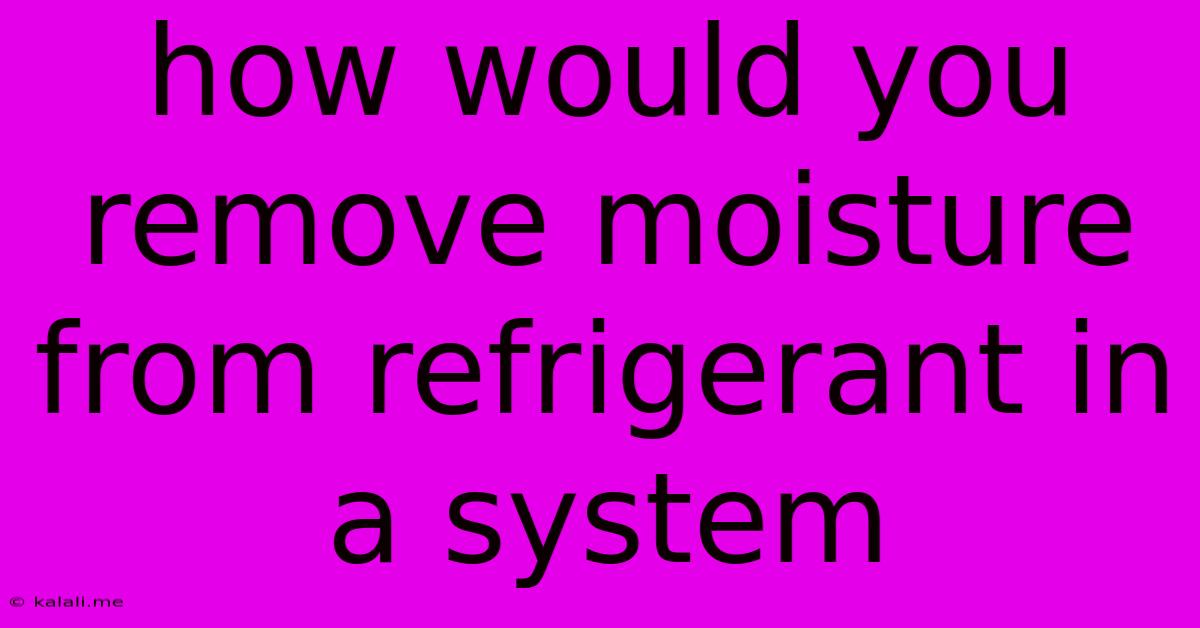How Would You Remove Moisture From Refrigerant In A System
Kalali
Jun 12, 2025 · 3 min read

Table of Contents
How to Remove Moisture from a Refrigerant System: A Comprehensive Guide
Meta Description: Learn how to effectively remove moisture from your refrigerant system. This guide covers identifying moisture contamination, preventative measures, and various removal techniques for optimal system performance.
Moisture in a refrigerant system is a serious problem. It can lead to reduced efficiency, equipment damage, and costly repairs. Understanding how moisture gets into the system, identifying its presence, and effectively removing it are crucial for maintaining optimal performance and extending the lifespan of your refrigeration equipment. This article provides a comprehensive guide on dealing with moisture in refrigerant systems.
How Moisture Enters a Refrigerant System
Moisture can enter a refrigerant system through several pathways:
- Leaking Components: Damaged seals, cracked lines, or other leaks allow atmospheric moisture to infiltrate the system. This is a common cause, especially in older systems.
- Improper Charging Procedures: Introducing moisture during the charging process is easily done if proper procedures aren't followed, such as using contaminated refrigerant or improper evacuation techniques.
- Improper Installation: If the system isn't properly installed, moisture can be trapped during assembly.
- Condensation: Moisture can condense within the system if temperature differences allow for it. This is more likely in systems with poor insulation or fluctuating operating temperatures.
Identifying Moisture Contamination
Detecting moisture in a refrigerant system can be challenging, but several methods are available:
- Moisture Indicators: Many refrigerant systems include sight glasses or moisture indicators that change color in the presence of moisture. These provide a quick visual check.
- Refrigerant Analysis: A refrigerant sample can be analyzed in a laboratory to determine the exact level of moisture contamination. This is a more precise but costly method.
- Pressure-Temperature Readings: Discrepancies between the actual pressure-temperature readings and the expected values can indicate the presence of non-condensables, including moisture. This method requires experience and understanding of the system's specifications.
- System Performance Issues: Reduced cooling capacity, increased compressor run time, and frosting in unexpected areas are all signs of potential moisture problems.
Methods for Removing Moisture from a Refrigerant System
Several methods can remove moisture from a refrigerant system, ranging from simple preventative measures to more involved procedures.
- Proper Evacuation: Thorough evacuation before charging is crucial. This involves using a vacuum pump to remove air and moisture from the system for a sufficient amount of time, usually measured in microns of vacuum. The longer the evacuation, the more moisture is removed. This is the most effective preventative measure.
- Refrigerant Dryers/Filters: These devices filter out moisture and other contaminants from the refrigerant as it circulates. Regularly changing or replacing these filters is essential for continued effectiveness.
- Using a Refrigerant Dehydrator: A refrigerant dehydrator is a device specifically designed to remove moisture from refrigerant. It often includes a filter drier and other components to effectively remove impurities.
- Purging the System: In cases of severe contamination, a complete system purge may be necessary. This involves completely emptying the system, cleaning it thoroughly, and then recharging it with dry refrigerant. This is a more complex and time-consuming process, often requiring specialized equipment.
Preventative Measures
Preventing moisture contamination is significantly easier than removing it. These steps can help:
- Regular Maintenance: Regular inspections and maintenance checks can identify potential leaks or other issues before they become major problems.
- Proper Handling of Refrigerant: Use only clean, dry refrigerant and ensure proper handling procedures are followed during charging and maintenance.
- Proper System Design and Installation: Ensuring the system is designed and installed correctly minimizes the risk of moisture entry.
- Use of High-Quality Components: High-quality components are less prone to leaks and are more durable, reducing the risk of moisture ingress.
Removing moisture from a refrigerant system requires careful attention to detail and may necessitate professional assistance, especially in more complex situations. By understanding the causes, detection methods, and removal techniques, you can maintain a healthy and efficient refrigeration system for years to come. Always prioritize safety and consult qualified professionals when dealing with refrigerant systems.
Latest Posts
Latest Posts
-
Which Of The Following Occurs In Meiosis But Not Mitosis
Jun 13, 2025
-
Which Of The Following Diseases Are Caused By Viruses
Jun 13, 2025
-
Density Of Water At 4 C
Jun 13, 2025
-
Words To Describe A Good Mom
Jun 13, 2025
-
Electron Volt Is A Unit Of
Jun 13, 2025
Related Post
Thank you for visiting our website which covers about How Would You Remove Moisture From Refrigerant In A System . We hope the information provided has been useful to you. Feel free to contact us if you have any questions or need further assistance. See you next time and don't miss to bookmark.